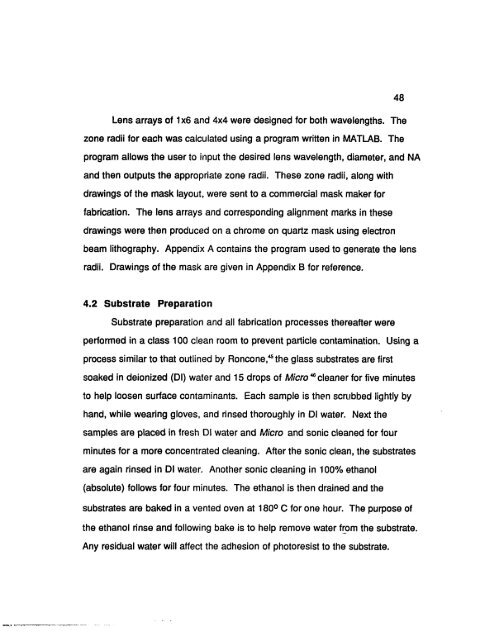azu_td_1349475_sip1_... - Arizona Campus Repository
azu_td_1349475_sip1_... - Arizona Campus Repository
azu_td_1349475_sip1_... - Arizona Campus Repository
Create successful ePaper yourself
Turn your PDF publications into a flip-book with our unique Google optimized e-Paper software.
48<br />
Lens arrays of 1x6 and 4x4 were designed for both wavelengths. The<br />
zone radii for each was calculated using a program written in MATLAB. The<br />
program allows the user to input the desired lens wavelength, diameter, and NA<br />
and then outputs the appropriate zone radii. These zone radii, along with<br />
drawings of the mask layout, were sent to a commercial mask maker for<br />
fabrication. The lens arrays and corresponding alignment marks in these<br />
drawings were then produced on a chrome on quartz mask using electron<br />
beam lithography. Appendix A contains the program used to generate the lens<br />
radii. Drawings of the mask are given in Appendix B for reference.<br />
4.2 Substrate Preparation<br />
Substrate preparation and all fabrication processes thereafter were<br />
performed in a class 100 clean room to prevent particle contamination. Using a<br />
process similar to that outlined by Roncone.^the glass substrates are first<br />
soaked in deionized (Dl) water and 15 drops of Micro 48 cleaner for five minutes<br />
to help loosen surface contaminants. Each sample is then scrubbed lightly by<br />
hand, while wearing gloves, and rinsed thoroughly in Dl water. Next the<br />
samples are placed in fresh Dl water and Micro and sonic cleaned for four<br />
minutes for a more concentrated cleaning. After the sonic clean, the substrates<br />
are again rinsed in Dl water. Another sonic cleaning in 100% ethanol<br />
(absolute) follows for four minutes. The ethanol is then drained and the<br />
substrates are baked in a vented oven at 180° C for one hour. The purpose of<br />
the ethanol rinse and following bake is to help remove water from the substrate.<br />
Any residual water will affect the adhesion of photoresist to the substrate.
















